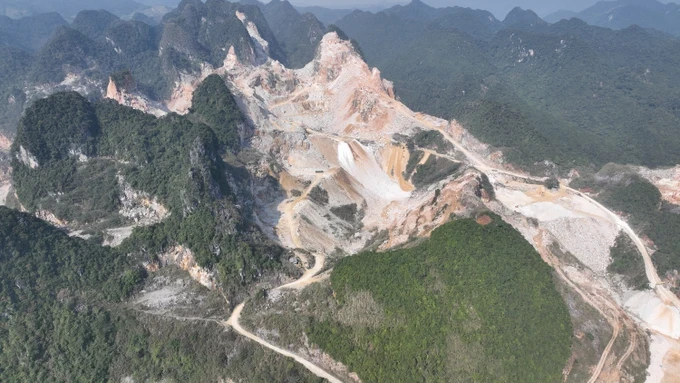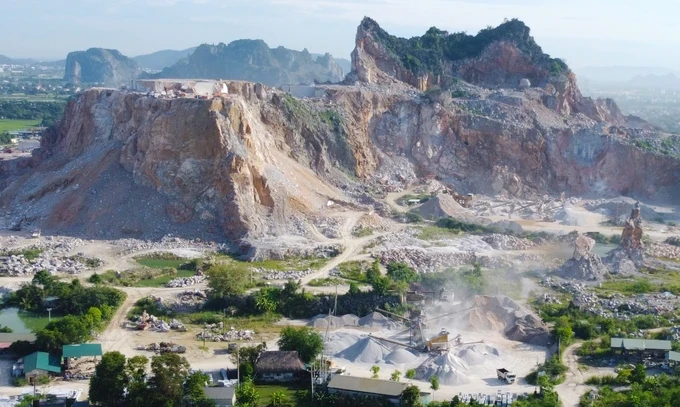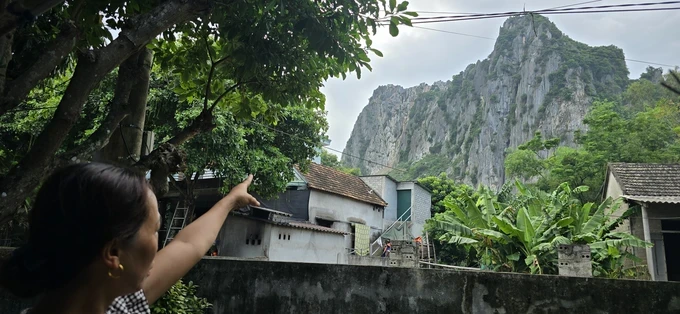
In Quy Hop District of Nghe An Province, renowned as a mineral-rich region, the relentless assault on the environment is evident. The once pristine landscapes of Chau Hong and Chau Tien communes have been scarred by the incessant movement of heavy-duty trucks transporting soil and rocks. Local officials recount the detrimental effects of rampant mining on the region, including the formation of sinkholes and the depletion of groundwater sources.
Chau Hong Commune used to accommodate 22 tin and white rock mines. The exploitation left behind a bitter legacy for the people. In some villages like Na Noong, Na Hieng, Poong, and Hy, sinkholes appeared, while hundreds of wells suddenly dried up. Although there's no official conclusion yet, local residents assert that these are the consequences of deep mining and groundwater extraction for ore washing.

Similarly, in Thanh Hoa Province, the majestic Vuc Mountain has been subjected to relentless quarrying, leaving behind a scarred and mutilated landscape.
Residents of Ky Trinh Ward (Ky Anh Town, Ha Tinh Province) have expressed deep concern over the discovery that Hong Ha Trading and Construction Services Co. has exceeded its authorized mining quota by 68 percent (approximately 1,000 cubic meters of soil). Meanwhile, in Hung Tri Ward of the same town, Hoa Binh Construction JSC. has been mining beyond the permitted area by around 16,897 square meters.

Traveling north from Ba Don Intersection on National Highway 1A into the upper reaches of the Gianh River, it is not hard to witness the pervasive scarring of the landscape by countless "parasitic" quarries, relentlessly excavating the towering limestone mountains. Once revered as the "Ha Long Bay on land," these majestic mountains have been transformed into barren, lunar-like landscapes. The iconic Len Bang Mountain, once a natural wonder, has been exploited for its limestone, losing 24 million tons of material to the cement industry.
Along the central coast of Vietnam, in provinces such as Binh Dinh and Phu Yen, lush hills are being relentlessly exploited. The giant mountain of Son Trieu (Binh Dinh Province) is being ravaged by dozens of quarries. Similarly, in Phu Yen Province, the hills around Song Cau Town and Tuy An District are being extensively excavated. Elderly residents, such as Nguyen Phung Huan in Xuan Loc Commune, lament the destruction of the once-lush forests in the Cu Mong mountain range.
Near Len Bang Mountain in Tien Hoa Commune (Quang Binh Province), residents have endured years of dust pollution from nearby quarries. Tran Xuan Son, a former village official, expressed concern about the constant threat of falling rocks (3,000 – 4,000 cubic meters in two years).
In another incident, Tran Thi Lieu was narrowly missed by a massive rockfall while working in her field, 200m away from a quarry. After that, a representative from the company exploiting the quarry quickly came and gave her VND200,000 (US$8) as compensation.

In Nghe An Province, the residents of Dong Thanh Commune have seen their peaceful lives disrupted by the establishment of several quarries on Len Co Mountain. According to Chairman Ngo Van Tuan of the Dong Thanh Commune People’s Committee, all the three current quarries are working not in compliance with the approved design. Despite government fines in 2023, these operations have continued unabated.
In Binh Dinh Province, a company has left behind deep, hazardous pits in Hoc Giang Mountain (Cat Nhon Commune, Phu Cat District), posing risks to livestock and the local community.
Local authorities have granted a company permission to use a network of deep pits, created by mining operations on Hoc Giang Mountain, as a dumping ground for limestone dust. Despite minimal waste disposal, the pits remain alarmingly deep. During rainfall, the pits release murky green water, raising concerns among residents about contamination. Chairman Nguyen Vu Bang of Cat Nhon Commune People's Committee acknowledged that these issues arose during a previous administration, making accountability difficult.
Thom Mountain, straddling Binh Hoa and Tay Binh communes in Tay Son District of Binh Dinh Province, is being excavated to provide fill material for a highway construction project. A local resident, N.T.Q., expressed outrage that approximately 100 ancestral graves belonging to the Nguyen clan have been inadvertently or deliberately buried under the excavated soil.
To procure fill material for Da Nang-Quang Ngai Expressway, Quang Nam Province previously granted permits to three companies, including Tuan Tri Company, Duy Nguyen Construction and Trading Company, and the Construction Engineering Corporation No. 4, to excavate Nong Bo Mountain in Duy Trung Commune, Duy Xuyen District.
However, upon completion of their mining operations, only Tuan Tri Company has submitted a mine closure plan to the provincial Department of Natural Resources and Environment. The other two companies have vanished.
An investigation at Nong Bo Mountain revealed a severely scarred landscape, with exposed bedrock and precariously perched boulders. A local driver expressed concerns about the safety of the expressway, particularly during heavy rain when loose rocks could pose a significant hazard.
Similarly, in Chau My Hill (Thang Binh District, Quang Nam Province), a mining company abandoned a quarry site in 2017 without restoring the land.
Throughout Lam Dong Province, mountains have been disfigured by mining operations. In Da Lat City, Du Sinh Mountain has been extensively quarried, and the once-lush pine forests have been replaced by barren, rocky landscapes. The exploitation of kaolin in Bao Loc has left deep pits and devastated the region's tea, pine, and coffee plantations.
























